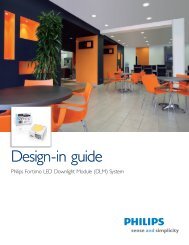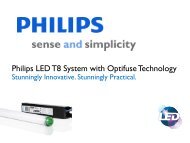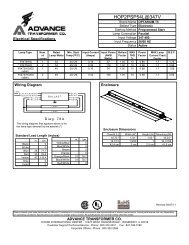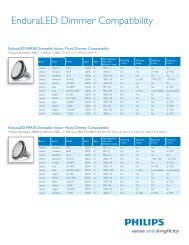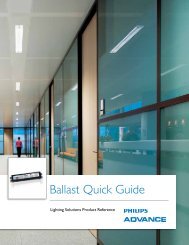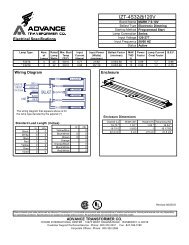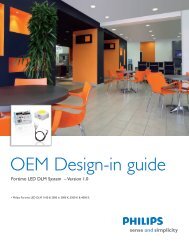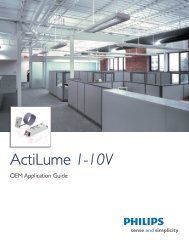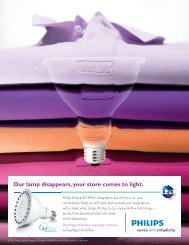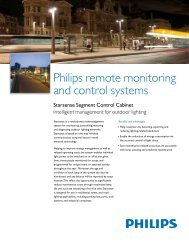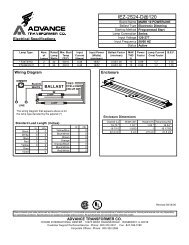Philips QL Induction Lighting Systems - Philips Lighting
Philips QL Induction Lighting Systems - Philips Lighting
Philips QL Induction Lighting Systems - Philips Lighting
- No tags were found...
You also want an ePaper? Increase the reach of your titles
YUMPU automatically turns print PDFs into web optimized ePapers that Google loves.
1. General information on <strong>Philips</strong> <strong>QL</strong> induction lamp systems<br />
1.1 Introduction<br />
The <strong>QL</strong> lamp systems use a unique physical principle of light<br />
generation. This lamp system is therefore classified in a new<br />
family of sources, the <strong>QL</strong> induction lamp systems.<br />
<strong>QL</strong> induction lighting is a breakthrough for professional,<br />
general and special lighting applications; not only because of<br />
its high luminous efficacy and excellent light quality, but<br />
especially because of its unprecedented lifetime. System<br />
lifetime is rated at 60,000 hours, or about 15 years (based<br />
on 4000 burning hrs/year) in many applications, with a failure<br />
rate of less than 10%. Average lifetime with 50 % survivals is<br />
rated at 100,000 hrs. With this unmatched durability, <strong>QL</strong><br />
offers substantial savings in direct maintenance costs, as<br />
well in indirect costs. The major features of <strong>QL</strong> lamp<br />
systems, and their related benefits for the user, are:<br />
Features:<br />
Benefits:<br />
1.2 Lamp system technology and<br />
operation<br />
1.2.1 Operating principle<br />
<strong>QL</strong> induction lighting is based on a principle, which is<br />
fundamentally different from that of conventional fluorescent<br />
lamps (e.g. TL-D, TL-5 or PL type lamps).<br />
In conventional fluorescent lamps the electric current is<br />
supplied to the gas discharge through the glowing<br />
electrodes. In <strong>QL</strong> induction lamps the electrical energy is<br />
supplied to the gas discharge by means of a high frequency<br />
electromagnetic field without any electrodes. In conventional<br />
discharge lamps the electrodes mostly are the lifedetermining<br />
factor. Since these electrodes are not present in<br />
<strong>QL</strong> induction lamps, life of <strong>QL</strong> lamps can be very long.<br />
Ferrite<br />
No electrodes or filaments<br />
• ultra long life time of < 10 % failure • high reliability and nearly<br />
rate at 60,000 hrs<br />
maintenance free operation<br />
• low lumen depreciation of < 30 % at • lasting high light output right through<br />
60,000 hrs<br />
lifetime<br />
• low operating temperature of • increased safety: more standard<br />
components<br />
luminaire construction<br />
High frequency operation<br />
• high system efficacy (65-70 lm/W) • economic, environment-friendly<br />
lighting in situations with long<br />
burning hours<br />
• no flickering<br />
• restful- non fatiguing light<br />
• no stroboscopic effect<br />
• no noise<br />
Electronic control<br />
• output protected HF generator<br />
Instant (re-)start<br />
• when needed light always instantly<br />
available<br />
3-line fluorescent coating<br />
• no danger with rotating machinery<br />
• restful and non disturbing in<br />
operation<br />
• automatic switch off in case of<br />
failure of lamp.<br />
• more comfort<br />
• extra energy saving feasible in<br />
combination with presence<br />
detectors<br />
• suitable for security and safety<br />
lighting<br />
• useful light immediately after switch<br />
on<br />
• choice of color temperature<br />
• white light<br />
• good color rendering (Ra>80)<br />
Amalgam controlled Hg-vapor pressure<br />
• constant light output over a wide<br />
range of ambient temperatures<br />
Table 1: Features and benefits of <strong>QL</strong> lamp system<br />
I P<br />
Figure 1: <strong>Induction</strong> principal<br />
H<br />
I S<br />
3



